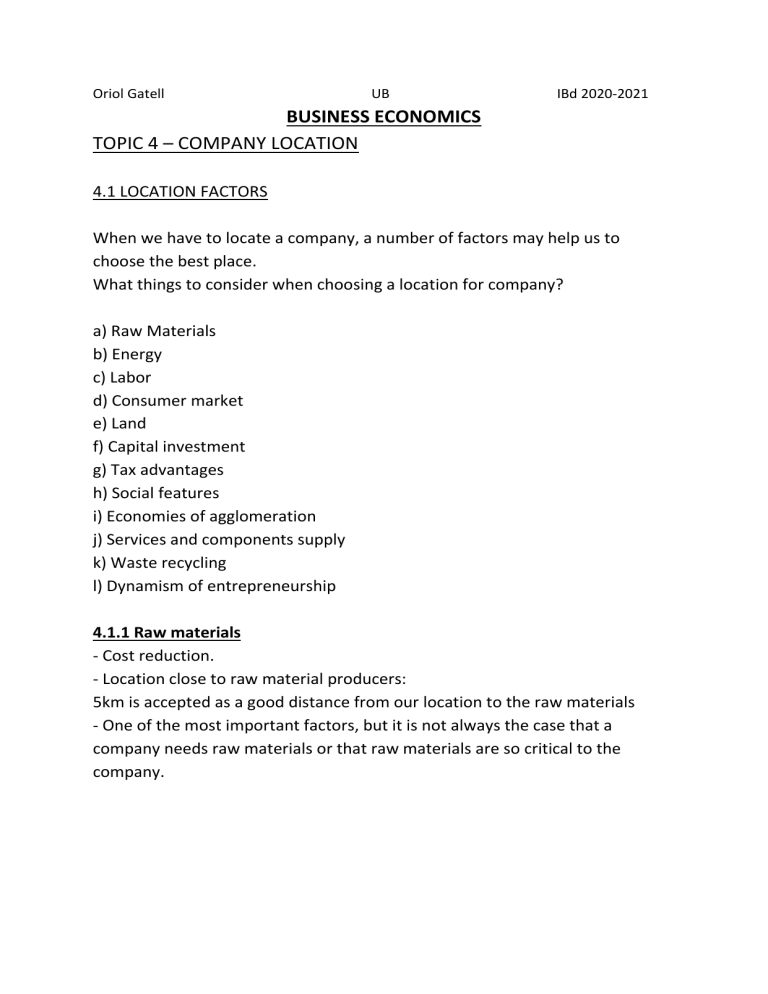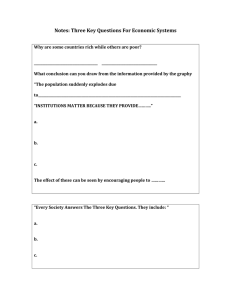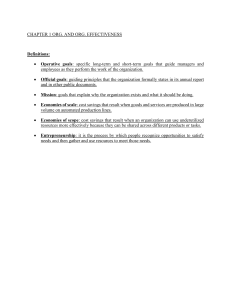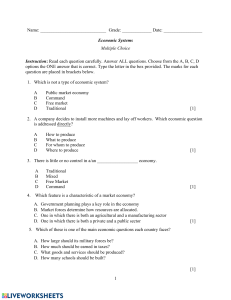
Oriol Gatell UB IBd 2020-2021 BUSINESS ECONOMICS TOPIC 4 – COMPANY LOCATION 4.1 LOCATION FACTORS When we have to locate a company, a number of factors may help us to choose the best place. What things to consider when choosing a location for company? a) Raw Materials b) Energy c) Labor d) Consumer market e) Land f) Capital investment g) Tax advantages h) Social features i) Economies of agglomeration j) Services and components supply k) Waste recycling l) Dynamism of entrepreneurship 4.1.1 Raw materials - Cost reduction. - Location close to raw material producers: 5km is accepted as a good distance from our location to the raw materials - One of the most important factors, but it is not always the case that a company needs raw materials or that raw materials are so critical to the company. 4.1.2 Energy To reduce costs the company should be near power lines. - If some specific energy is needed (solar, heat, oil, etc.), this should be considered. - Access to energy must be as easy as possible (rivers, mountains, etc. can hinder access). 4.1.3 Labor - Qualified labour in the location? - Salaries? - Specific qualities (universities, tradition…) - Labour law? 4.1.4 Consumer market - The closer, the quicker - Cost reduction - Customers are closer, we can get more information about their preferences 4.1.5 Land - Cost? - Other companies around? - Infrastructure and services? - Rivers, mountains, weather? - Company concentration close? 4.1.6 Capital investment - Some locations have easier access to private capital than others - Proximity to financial cities increases the probability of receiving investments 4.1.7 Tax advantages - Some regions have special laws that apply to companies operating there - Better prices, specific infrastructure … - Tax discounts - Easier public investment 4.1.8 Social features - There are regions with more social activity than others - The power of labor is different too - The past may be important (bankruptcies, strikes…) - Media? 4.1.9 Economies of agglomeration Lots of companies and people in the same area can produce: 1) Internal economies: The bigger the company, the lower the costs. 2) Location economies: Different companies in the same activity located in the same area get lower costs and better services for all of them. 3) Urban economies: Companies may improve, but consumers should improve too or the market won’t absorb production. 4.1.10 Services and components supply Companies need lots of services, and companies that offer those services include: - Lawyers - Cleaning - Media - Etc. 4.1.11 Waste recycling Some companies (chemical, manufacturing …) produce tones of wastes that must be recycled. - Laws on recycling are very strict, companies must be responsible for this activity. - Location of recycling areas must be not far from company’s manufacturing plants. 4.1.12 Dynamism of entrepreneurship - Government pays more attention to area with higher dynamism. - Better services and infrastructure. - More competitors – better product 4.2 SOME QUANTITATIVE METHODS TO EVALUATE LOCATION 4.2.1 Location methods How can we evaluate the best location for our company? There are many factors that influence the decision, so how should we prioritize them? We should consider all of them, so this will be a multi-criteria decision. Location can affect both costs and revenue We will analyze 2 cases: a) Revenue changes with location b) Revenue is independent of location In both cases we will assume that costs are always dependent on location. And then, we will be more specific: • Gravitational center method • Weighted factors method 4.2.2 Revenue changes with location Revenue is affected by location. Costs are: Company A: FC low, VC high. Sales higher than B. Company B: FC higher, VC lower. Sales smaller than A. In this case, company A has higher costs and higher revenue, but the cost difference (ΔTC) is smaller than the difference in revenue (ΔTR). Company A will have better results. P=30 Q(A)=10, Q(B)=5 FC(A)=70 FC(B)=80 VC*(a)=15 VC*(B)=6 TR(A)=30 x 10= 300 TR(B)=30 x 5=150 TR: TR(A)-TR(B) TR=300-150=150€ 1- (A)>(B) ----- (A-B) ----- TR>TC= A 2- (A)>(B) ----- (A-B) ----- TR<TC= B 3- (A)<(B) ----- (B-A) ----- TR>TC= B 4- (A)<(B) ----- (B-A) ----- TR<TC= A TC(A)=70+(15 x 10)=220 TC(B)=80+(6 x 5)=110 TC: TC(A)-TC(B) TC=220-110=110€ TR (150) > TC (110) = A Company will have better benefits P=30 Q(A)= 10 FC(A)= 70 VC*= 20 Q(B)= 5 FC(B)= 80 VC*= 6 TR(A)= 30 x 10= 300 TR(B)= 5 x 30= 150 TR(A)-TR(B) TR: 300-150= 150 TC(A)= 70+20 x 10= 270 TC(B)= 80+6 x 5= 110 TC(A)-TC(B) TC: 270-110= 160 TR(150)<TC(160)= Company B will have better results 4.2.3 Revenue is independent of location Revenue is not affected by location, costs are. Locational Cost-Profit-Volume Analysis A technique for evaluating location choices in economic terms Steps: 1. Determine the fixed and variable costs for each alternative 2. Plot the total-cost lines for all alternatives on the same graph 3. Determine the location that will have the lowest total cost for the expected level of output. Cost functions: TC = FC + VC = FC + VC*✕Q If Q<100, A has the lowest costs. If 100<Q<500, D is the best choice. If 500<Q<1000, B is the best choice. If Q>1000, C is the best choice. 4.2.4 Gravitational center method This method considers “transport” as the most important factor • Origin and destination points are the variables in this method • What the method finds is the central point with the smallest distance between origins and destinations Steps: 1) Map showing destinations 2) Coordinate system added 3) Center of gravity If quantities to be shipped to every location are equal, you can obtain the coordinates of the center of gravity by finding the average of the x-coordinates and the average of the y-coordinates. xi = x coordinate of destination i yi = y coordinate of destination I n = number of destinations We are attempting to find the center of gravity for Problem 1 which is presented in the graphic. Steps: 1) Map showing destinations 2) Coordinate system added 3) Center of gravity 4.2.5 Weighted factors method Here we take many factors into consideration, and we try to find the best location according to all of them. Steps: 1) Identify relevant factors – key success factors 2) Assign a weight to each factor according to their relative importance (wj) 3) Evaluate each factor by defining scores (Pij ) 4) We get a number (Pi) that represents each alternative, taking all the factors and their weighted importance into consideration: (Alternative i taking all factors j into consideration) 5) Recommend the location with the highest point score Problem 2. A shoe company wants to open a new store. We have available information on two potential locations. We need to decide which is better? A shoe company wants to open a new store. We have available information on two potential locations. We need to decide which is better? Steps: 1)Identify relevant factors – key success factors 2) Assign a weight to each factor according to their relative importance (wj) 3) Evaluate each factor by defining scores (Pij ) 4) We get a number (Pi) that represents each alternative, taking all the factors and their weighted importance into consideration. 5) Recommend the location with the highest point score



